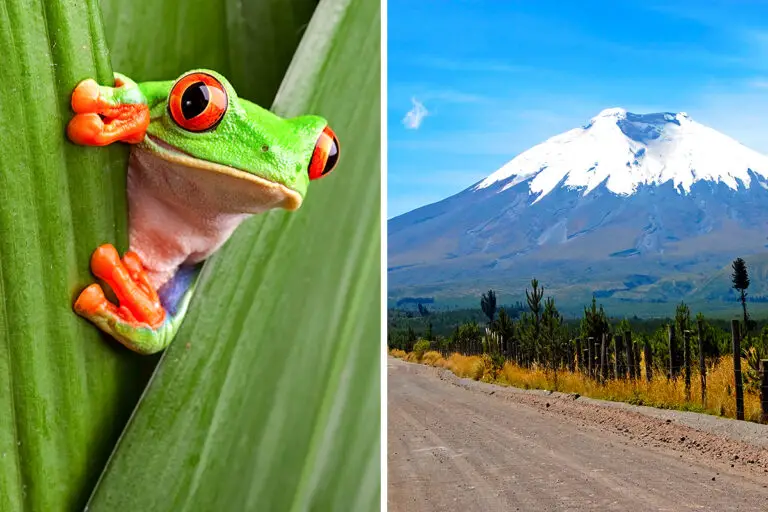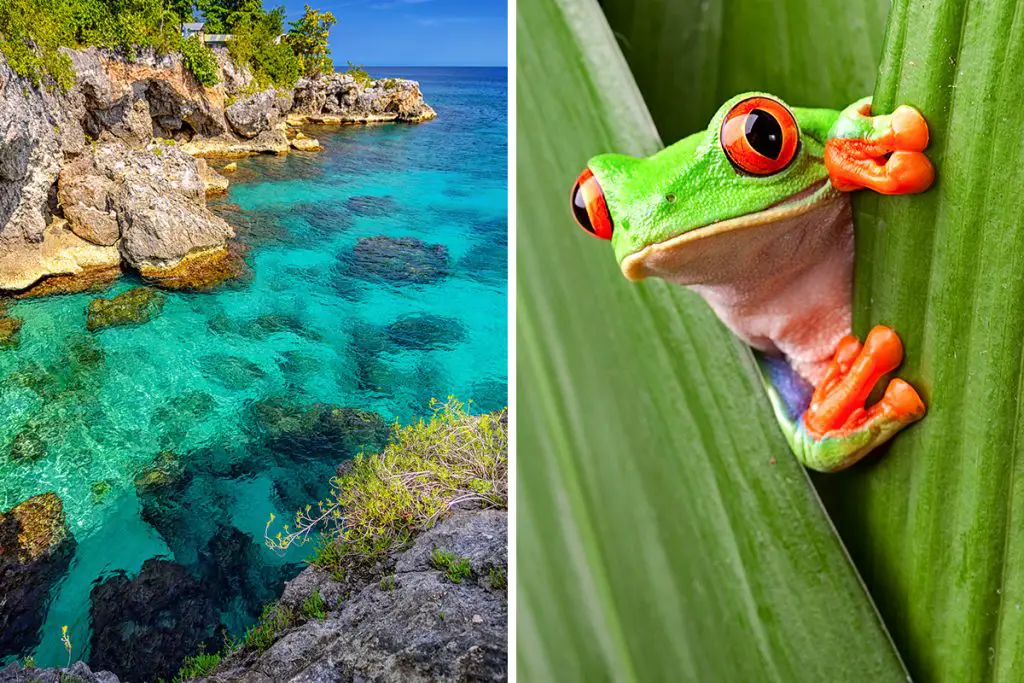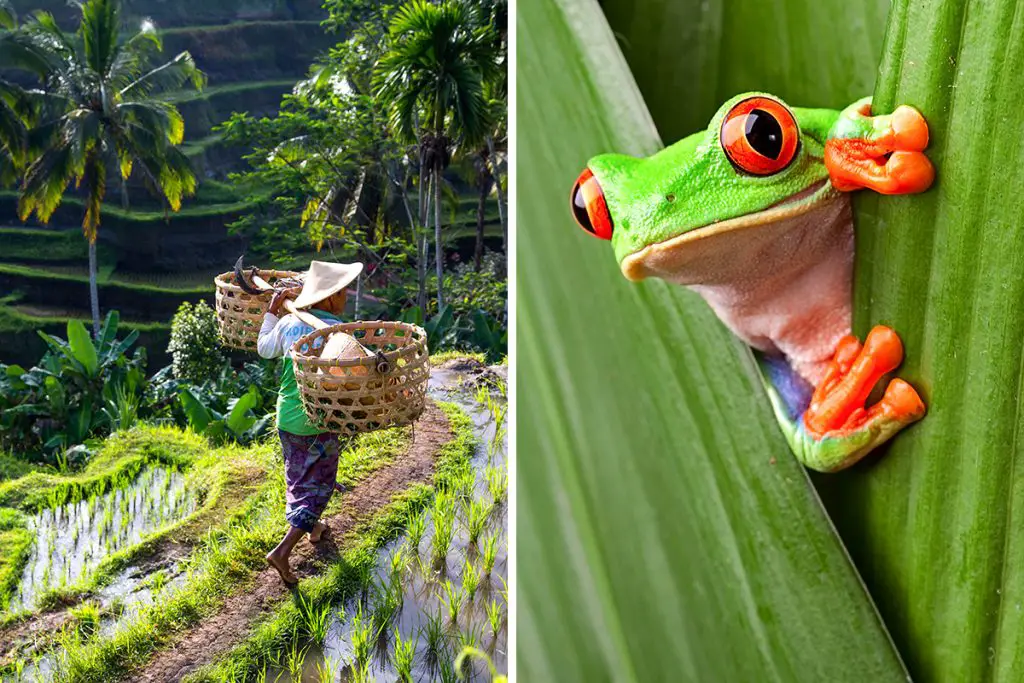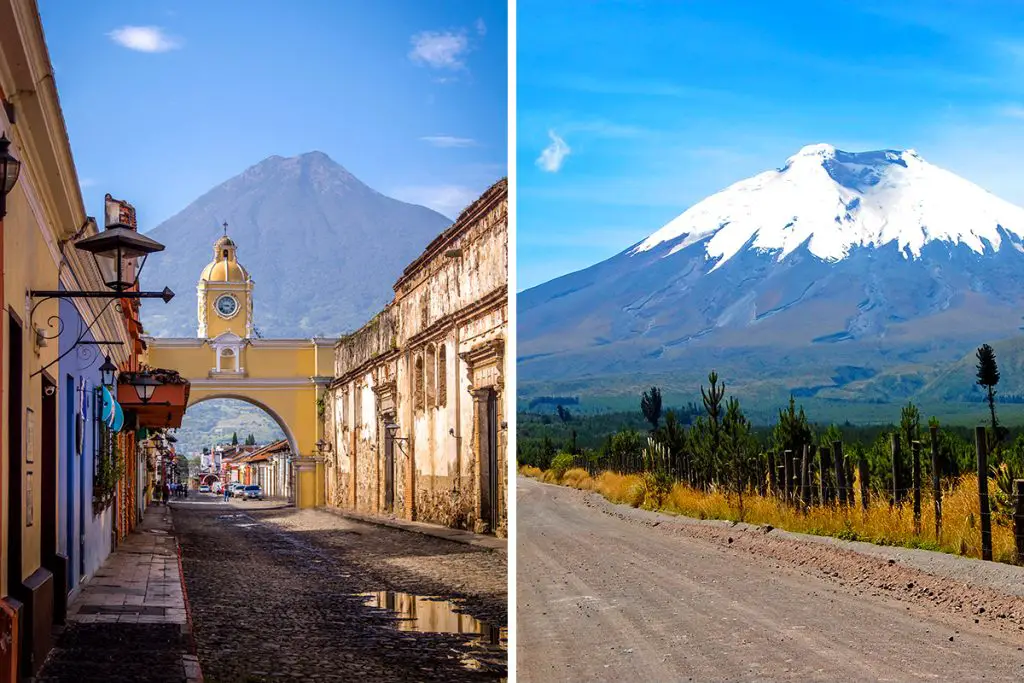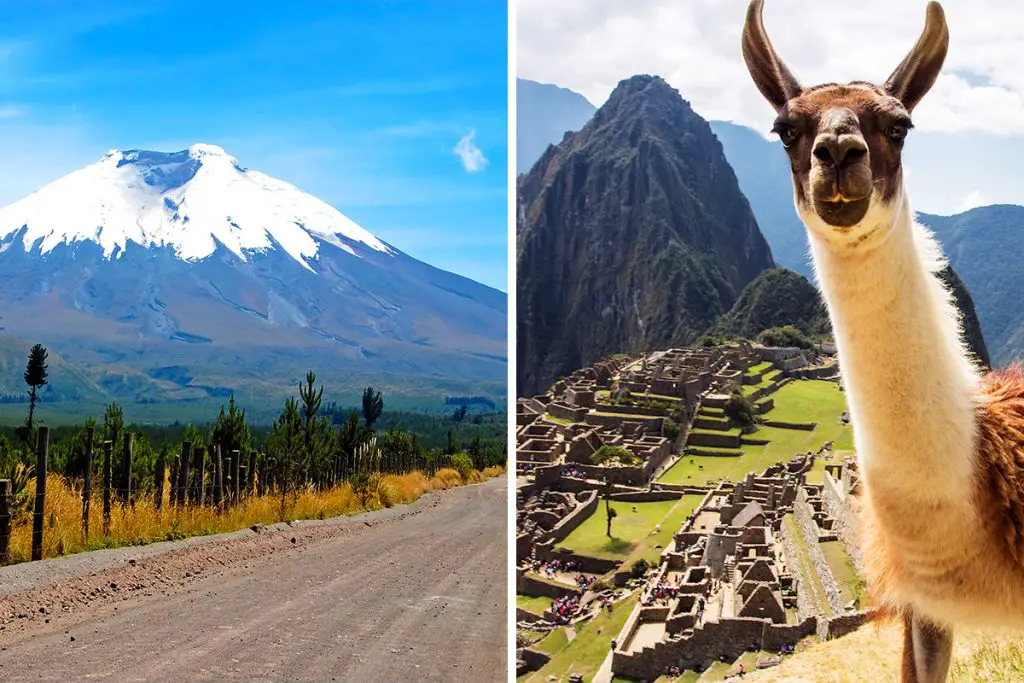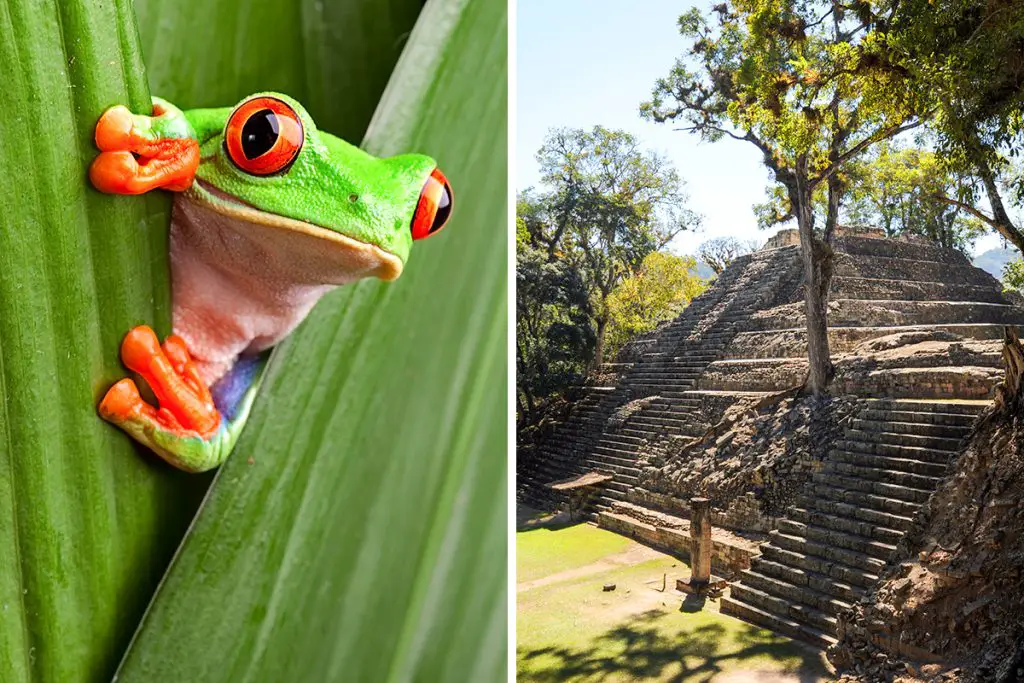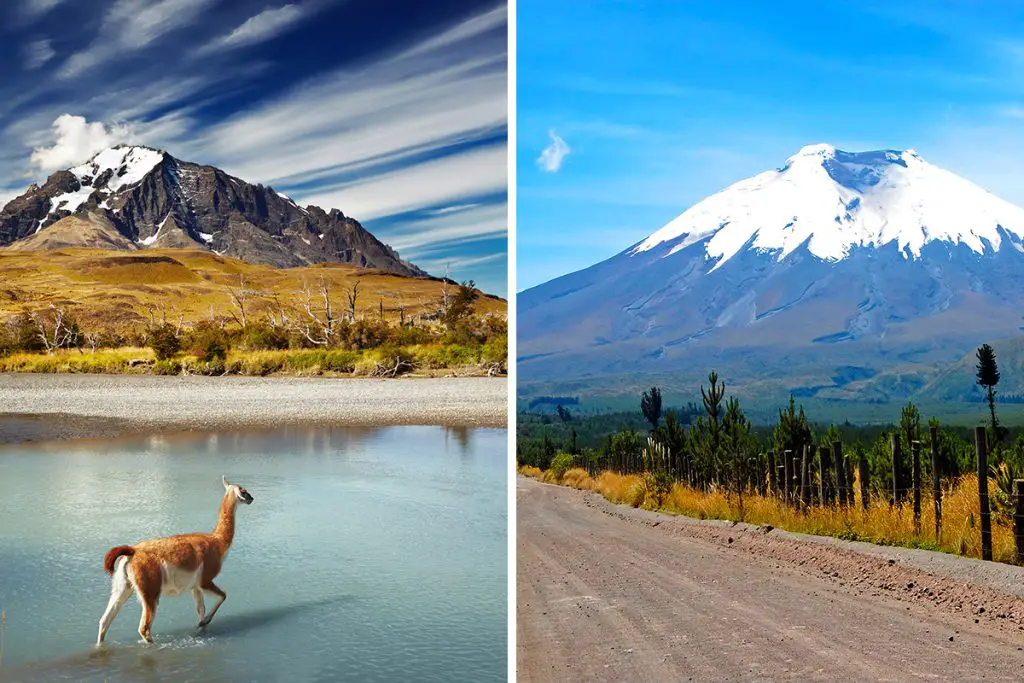Costa Rica is a beautiful country with a lot of natural attractions. The climate is diverse, so it’s possible to visit the country all year round. Costa Rica has a high biodiversity level, making it interesting for nature lovers and bird-watchers.
Ecuador has a rich history of indigenous cultures, Spanish colonialism, and modern-day globalization. It has beautiful beaches on its coasts but also has jungles home to hundreds of species native to this region of South America.
Costa Rica
If you’re looking for a country with it all, look no further than Costa Rica. It boasts a wide variety of landscapes and climates – meaning there are endless things to do and see. From volcanoes to beaches, dense jungles to bustling cities, surfing spots to rainforests – no matter what kind of adventure you seek while exploring this Central American gem, you will find it here!
Costa Rica is a very safe country. There are no major problems with crime or violence. The police force is well trained and provides good security for travelers to Costa Rica.
Costa Rica is a tropical paradise, with over half of its land covered in rainforest. It’s also home to an impressive diversity of plant and animal life, including over 12,000 species of moths. It’s even got a little bit of everything: beaches, mountains, volcanoes, jungles—and it’s all an affordable plane ride away from the U.S. so that you can get there fast.
What Makes Costa Rica Unique
Wealth of Wildlife
Costa Rica is an excellent place to visit if you want to see the wildlife in its natural habitat. It has a lot of wildlife diversity, making it possible for tourists to see various animals.
Known as the “Switzerland of Central America,” Costa Rica is one of the most biodiverse countries in the world. It has a wealth of wildlife, including more than 1,500 species of butterflies, over 850 species of birds, and 194 different amphibian species.
Costa Rica has a large percentage of wilderness in Central America, and it is home to 6% of all plants and animals found in the world. The country’s rich biodiversity is a product of its location at the intersection of three major continents. This is the main reason why hundreds of species are endemic to Costa Rica.
28 National Parks
With the slogan “Pura Vida” (“Pure Life”), Costa Rica is one of the most biodiverse countries in the world. The country has more than 28% of its land protected by law as national parks and reserves, with much of it accessible for tourism.
Costa Rica has 28 national parks that protect and preserve the country’s amazing wildlife. Among these 28 national parks are 3 UNESCO World Heritage Sites you should not miss once you go to Costa Rica.
Area de Conservación Guanacaste
One of the 3 UNESCO World Heritage Sites in Costa Rica is the Area de Conservación Guanacaste. It is in the northwestern part of the country. The area is home to various wildlife species, including jaguars, pumas, snakes, and armadillos.
The park has three distinct zones: dry forest, wet forest, and mangrove swamp. It includes several mountains, such as Cerro de la Muerte (Mountain of Death), which reaches an altitude of 3,451 meters (11,322 feet) above sea level.
The dry forest zone is home to many species of birds, including quetzals and hummingbirds, as well as monkeys, like howler monkeys and spider monkeys. There are also other mammals such as anteaters, kinkajous, coatis, and agoutis here.
While the wet forest zone has a humid climate that makes it ideal for plants such as orchids and bromeliads to grow. Some of these plants are endemic to this area, so they aren’t found anywhere else in Costa Rica or South America.
The mangrove swamp zone is home to many types of mangrove trees that thrive in the swampy environment. One of these trees is the red mangrove, which can grow up to 30 meters (98 ft) high and has roots that extend out into the water, acting as an anchor for itself.
Cocos Island National Park
Another UNESCO World Heritage Site in Costa Rica is the Cocos Island National Park. It is on the coast of Costa Rica, about 250 miles (400 kilometers) from the mainland. Visitors to Cocos Island National Park can enjoy snorkeling through its clear waters or scuba diving among its coral reefs. They may also explore its mangrove forests and volcanic caves.
Cocos Island National Park is one of the most important marine conservation areas and supports a wide variety of marine life. You’ll be able to spot whales, dolphins, and sea turtles as you explore the waters around this island—and if you’re lucky, even an oceanic white-tip shark!
You don’t have to worry about finding good snorkeling spots because there are hundreds at Cocos Island National Park! If you’re lucky enough to get there when the weather is good, you’ll see all kinds of colored fish swimming around you and sharks below the water’s surface.
If you’re looking for something more adventurous than snorkeling or swimming, you can try scuba diving! Scuba diving at Cocos Island National Park will give you an up-close look at the marine life that lives below the surface of the ocean around this island.
Talamanca Range-La Amistad Reserves / La Amistad National Park
The Talamanca Range-La Amistad Reserves / La Amistad National Park is a part of the 3 UNESCO World Heritage Sites in Costa Rica. It has a wide range of ecosystems and habitats, from cloud forests to rainforests to tropical dry forests. It is home to over 600 species of birds, 115 species of freshwater fish, and 250 species of reptiles and amphibians
You can hike through this beautiful park on foot. But a guide is essential while hiking to help you navigate this tremendous park. A guide will not only spot wildlife but also keep hikers on the designated paths, creating a safe and incredible trip.
Breathtaking Beaches
Costa Rica has many different types of beaches — some sandy and others rocky. Most beaches have nearby hotels and restaurants but offer activities like diving, snorkeling, or kayaking. Many of these activities are available through tour agencies that specialize in them.
Nosara Beach is a more upscale beach and has excellent facilities, including a hotel with a spa and great restaurants. This is a great place for families who want to relax on their vacation without paying high prices for expensive hotels or resorts nearby.
The other major beach area is Manuel Antonio National Park on the Caribbean side of Costa Rica’s Central Pacific Coast. It has some very famous beaches like Sirena, which means mermaids, Playa Hermosa, and Poás Volcano Crater Beach, also a national park.
Lastly, you must visit Playa Blanca if you want to see white sand living up to its name which literally means “white beach.” The main attraction of Playa Blanca is its beautiful white-sand beach and calm turquoise waters. The surf can be intense sometimes, but it’s not dangerous unless you go too far into the ocean.
Stable Climate
The temperature in Costa Rica stays stable throughout the year since it is close to the equator. In fact, Costa Rica’s latitude is 10 degrees north of the equator. This means that months like March and April in Costa Rica can get very hot, with temperatures in the 90°F (32°C).
The best time to visit Costa Rica would be during their dry (and bright) season, from December through April or May, when there are fewer tourists and prices are lower.
It is also recommended to visit Costa Rica during its green season, which is from November or May to June.
Ecuador
Ecuador is a country that has a fascinating history, but it also has an exceptional natural environment. It’s one of the most biodiverse countries in the world and has some of the most beautiful beaches and islands.
It has everything from beautiful mountains to dense jungles, making it a popular tourist destination. There are many different places in Ecuador that you can visit, and each one is unique and exciting in its way.
Ecuador has a lot to offer. From the stunning Andes Mountains in the west to the Amazon rainforest in the south and the beautiful Galapagos Islands in the east, Ecuador’s diverse geography offers a unique experience that few other places can compare. That said, here is a list of places you should visit once you visit Ecuador.
What Makes Ecuador Unique
Galapagos Islands
Galapagos Islands are a paradise for those who love nature. Here you will find volcanoes, beaches, lakes, and many other natural attractions that make the Galapagos one of the best places to visit in the world.
The Galapagos Islands are a group of volcanic islands that belong to Ecuador. It is in the Pacific Ocean, about 620 miles (1,000 kilometers) from mainland Ecuador. The archipelago consists of 13 large islands, and many small islets have formed over time due to tectonic shifts and eruptions.
Charles Darwin Research Station
Charles Darwin Research Station is a small research facility located on Isla Isabela. The station began in 2004 and studied the natural history of the Galapagos Islands. The Charles Darwin Research Station has many educational exhibits showcasing different types of animals, including tortoises, birds, and mammals.
Visitors go to the Charles Darwin Research Station to visit Lonesome George – the last remaining Pinta Island giant tortoise. Visitors to the CDRS can see Lonesome George and learn about his life and the plight of the Pinta Island tortoises.
The Charles Darwin Research Station is home to one of the world’s largest collections of tortoises. There are more than 2,000 tortoises at the station, and they appear on daily tours. Visitors can also visit an area where they can view some of these tortoises in their natural habitat.
Sullivan Bay
Sullivan Bay sits along Santiago Island’s eastern coast. The most memorable part of a visit here is a 1-mile (1.6-kilometer) walk through striking pahoehoe lava. Pahoehoe lava is a solidified lava with a puffy and wavy surface.
The bay is famous for its beautiful pahoehoe lava formations that make up a large part of the shoreline. This type of lava forms when molten lava cools on the sea floor with air pockets trapped inside it. As the lava solidifies, it forms one or more layers that can be as thick as 6 meters (20 feet). The color ranges from pinks to oranges and reds depending on how hot the lava was when it cooled.
Quito
Quito is Ecuador’s capital and one of South America’s oldest cities. What’s fantastic about it is that the entire city of Quito is a UNESCO World Heritage Site. It is also known for its colored colonial buildings and narrow cobblestone streets. These streets are lined with shops selling artisanal goods such as alpaca wool sweaters.
La Virgen de Quito
La Virgen de Quito is one of the most iconic landmarks in El Panecillo, a famous hill in Quito. It was built in 1976 by Spanish artist Agustin de la Herran Matorras and is a luminous statue of the Virgin Mary that stands 200 meters (656 feet) tall. The sculpture has become one of Quito’s most popular attractions, drawing hundreds of visitors daily.
The aluminum statue is visible throughout the entire city during daylight hours. At night, it is lit by thousands of lights inside and on its exterior walls so that it appears as if she were glowing with light.
The statue also attracts tourists who come to see it at night because they believe she gives off an aura that makes them feel better around her. This legend has continued throughout generations and continues to inspire people who visit there.
The Andes Mountains
The Andes Mountains is the longest continental mountain range on Earth. It runs for over 4,660 miles (7,500 kilometers) from Venezuela to Patagonia in South America.
The Andes Mountains is a true treasure and offers some of the best hiking and mountain biking in the world. This mountain range is home to twelve ecosystems, from tropical rainforests to temperate forests and high-altitude grassland.
Hiking in Andes Mountains
Hiking in Ecuador is very popular among tourists. Hiking through the Andes Mountains is an excellent way to see nature. It is the best way to get to know this mountain range. It is a very good experience for both kids and adults and families with children or teenagers.
Several hiking trails in the Andes Mountains lead up to high altitudes. The best time to hike is from May to October, when it is cooler and drier. If you want to see some of the most beautiful scenery in Ecuador, then hiking through the mountains will be your best option.
Mountain Biking in Andes Mountains
Mountain biking in Andes Mountains is another popular activity when visiting this country. It offers a unique experience that few other sports have ever offered before. Riding through beautiful nature while enjoying fresh air, sunshine, and views of snow-capped peaks at every turn!
Mountain biking in the Andes Mountains is an adventure available to tourists and locals alike. The range of mountains in this region offers a variety of terrain, each offering something different to explore. Bolivia’s Death Road and Ecuador’s Cloud Forest are two awe-inspiring places you can visit by mountain biking!
Rafting in Andes Mountains
Rafting in the Andes has many benefits, including fresh air, exercise, adventure, adrenaline rushes, and wildlife viewing. It is another way to connect with nature by learning more about the environment around you. All while floating down mountain rivers on large rubber rafts or kayaks.
The best time to go rafting is during the rainy season, which runs from May to November. If you go during this time, you can enjoy some of the best rapids in the world and even get wet on some days!
It is important to remember that there are many options for rafting in the Andes. This includes white water rafting, kayaking, and even boating! Tourists can enjoy rafting trips through Colombia’s Chicamocha Canyon, often called the Grand Canyon of South America—or paddle through a world-class white water river experience in Patagonia.
Amazon Rainforest
The Amazon Rainforest gets its name because it has more rain than any other place in the world. The rainforest receives a range of 2 meters (6 feet) to 10 meters (33 feet) of rainfall yearly! This means plenty of places in the Amazon Rainforest where you can get wet.
As the largest rainforest in the world, the Amazon Rainforest is one of the most biodiverse places on Earth. Here are a few things you can do once you visit the Amazon Rainforest:
Hike Through Old-Growth Rainforest
The further you hike into an old-growth rainforest, the more you’ll see and learn about the different species that live here. Hiking through a canopy walkway gives you a bird’s-eye view of trees as high as 61 meters (200 feet) tall that tower over you. You may even spot monkeys or sloths hanging from branches!
Enjoy Kayaking in Pristine Waters
Kayaking is a great way to explore parts of the Amazon River without getting wet! You can go out on calm days or go out on strong currents when it rains. Either way, you’ll be able to enjoy sitting next to beautiful lakes teeming with fish and wildlife.
Otavalo Market
Otavalo Market is an authentic market located in one of the most beautiful places in Ecuador. It is the capital of the Otavalo province, and it’s known as one of the oldest markets in Latin America. It has been around since the 17th century and has maintained its popularity among tourists and locals.
A reminder: the U.S. Dollar is Ecuador’s official currency. If you buy anything at Otavalo market, bring lots of small bills so no one will have trouble giving you change. There are many unique things you can do at Otavalo Market, including:
Visit One of the Many Artisans
A lot of Ecuadorian artisans sell their crafts at this market, such as embroidery or pottery. You’ll find a variety of stalls offering different products, from glassware to clothing items and more. These stalls will keep you busy for hours!
Eat Authentic Ecuadorian Food
You will find many restaurants that serve delicious authentic food from all over Ecuador in the Otavalo market. Some may specialize in chicken or fish, while others offer pasta dishes you won’t find anywhere else in the world. You can also try some fresh fruit at one of many stalls that offer exotic things like passionfruit, dragon fruit, and more. These restaurants are a must-try!
Buy Fresh Produce
You can buy fresh produce in Otavalo Market from Ecuador and products from other countries. You can find anything from coffee beans to spices, dried fruit, honey, and more. You will also find fresh fruits and vegetables grown in Ecuador.
Is Costa Rica Better Than Ecuador?
Ecuador and Costa Rica are two very similar countries, but one has a lot more to offer than the other. There are several differences between Costa Rica and Ecuador, such as their infrastructures, cultures, and ecosystems.
Costa Rica is more modern and developed, while Ecuador is more natural and rustic. Most of the people in Ecuador only speak Spanish, while many in Costa Rica also speak English. Ecuador is more traditional and religious, while Costa Rica is more open and secular.
Costa Rica also has a higher cost of living than Ecuador, making it less affordable for travelers on a budget. So, if you expect your spending money to go further, Ecuador would be a better choice than Costa Rica.
Both countries have so much to offer and will provide you with a very memorable experience. Depending on your preference and priorities, one will be better than the other.
FAQ
Is Ecuador or Costa Rica Cheaper?
Ecuador is the place to go if you’re looking for a cheaper destination. While Costa Rica is still affordable, it can be pricier than its South American counterpart.
You’ll find that your money goes further in Ecuador, exploring the Amazon rainforest or soaking up the sun on the Galapagos Islands. Prices for accommodation, food, and activities are all lower in Ecuador, making it an excellent option for budget-minded travelers.
Is Costa Rica Part of Ecuador?
No, Costa Rica is not a part of Ecuador. It is an independent country with its government and currency. The two countries are in different regions; Ecuador is in South America, while Costa Rica is in Central America.
Is Ecuador Near Costa Rica?
No, Ecuador is not near Costa Rica. Costa Rica is in Central America, while Ecuador is in South America. They are between a narrow strip of land called Panama.
Does Costa Rica Border Ecuador?
Costa Rica does not border Ecuador. Ecuador is between Colombia to the north and Peru to the south, while Nicaragua borders Costa Rica to the north and Panama to the south.
Where Is Ecuador in Relation to Costa Rica?
In relation to Costa Rica, Ecuador is on the west coast of South America. It is between Colombia to the north and Peru to the east and south.
Costa Rica to Ecuador Distance
The distance between Costa Rica and Ecuador is 14,278 km (887 miles). Although they are both parts of the American continent, they are quite far from each other.
How Do You Get From Ecuador to Costa Rica?
If you’re looking to travel from Ecuador to Costa Rica, you can travel by riding a plane, bus, or boat. The most popular way is to fly to Costa Rica’s main airport, Juan Santa Maria International Airport, which is in the capital city of San Jose.
Another way is to take a bus from Ecuador to Costa Rica. This can be a long journey, but it is doable and will save you some money.
You can also take a ferry from Panama to Costa Rica, a popular route for backpackers and travelers looking to save money.
Costa Rica to Ecuador Flights
To get to Ecuador from Costa Rica, you can either take the flight from San Jose (SJO), Costa Rica, to Guayaquil (GYE) or Quito (UIO) in Ecuador. The flight ticket ranges from 400 to 800 USD.
How Long Is the Flight From Costa Rica to Ecuador?
The flight from Costa Rica to Ecuador is short, taking a direct flight for over two hours. The direct flight from San Jose, Costa Rica, to Quito, Ecuador, is the quickest option offered by Avianca Airlines
Can You Drive From Costa Rica to Ecuador?
Yes, you can drive from Costa Rica to Ecuador. The trip will take you through some of the most beautiful sceneries in the world while having the chance to experience different cultures along the way.
There are a few things to keep in mind, though, before you embark on your journey. First, ensure your vehicle is in good condition and has all the necessary paperwork. Second, prepare for long driving days and plan your route. And finally, remember to enjoy the ride!
How Long Is the Drive From Costa Rica to Ecuador?
If you travel at a consistent speed of 50 kilometers per hour (31 miles per hour), it will take you approximately 29 hours to reach Ecuador from Costa Rica. This is a long drive, so plan and make plenty of stops along the way to rest and stretch your legs.
By breaking up the journey into smaller chunks, you can make the drive more bearable and less daunting. Remember to pack snacks and drinks for the trip, as well as books or other forms of entertainment to help pass the time.

